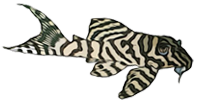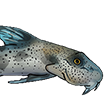Bas Pels wrote:Still, I wonder the nitrogen binding takes place in the gut. That is, after the food-mass has passed the stomach, which is (at least in mammals) the place where most of the protein downgrading takes place. Bacteria living in the gut will never enter the stomach – therefore I wonder where these bacteria will be processed.
Rabbits eat their own faeces in order to benefit from the bacteria in their gut – but as far as anyone knows, Panaque do not, and I don’t think their mouths are capable of doing this.
Obviously it could be Panaque has changed the order of processing – for a wood eater, having a stomach in the traditional sense (a place to digest protein) will not make sense – and having the right kind of protein in the last part of the gut would certainly make sense – but that would imply these proteins would have to be found.
Perhaps these are even very interesting – most likely the Panaque gut will never become as acidic as a stomach does – if it did, anatomical evidence (the special lining) would most likely been found.
mcdonal1 wrote:it would make sense that most protein digestion wold be occurring in the intestines.
Hi Bas Pels and Ryan,
I was following up on this issue and I came upon this title:
Mansilla, W., Columbus, D., Htoo, J. K., & de Lange, C. F. M. 2013. Urea nitrogen absorbed from the hindgut is used efficiently for body protein deposition in pigs fed a diet deficient in non-essential amino acid nitrogen. Energy and protein metabolism and nutrition in sustainable animal production, 134, 413-414. Alas, I don't have access to this work, but the abstract is intriguing:
Abstract
The absorption of nitrogen (N) from the hindgut of monogastric animals is thought to be of little value for supporting body protein synthesis. However, N that is absorbed from the lower gut, largely in the form of ammonia, can be used for synthesis of non-essential amino acids (NEAA) or converted to urea. The latter can be excreted in urine or recycled into the upper gut and contribute to microbial-produced amino acids that can be of benefit to the host (Fuller, 2012). The objective of the present experiment was to explore the efficiency of using N absorbed from the hindgut for body protein deposition in growing pigs fed a diet deficient in NEAA-N.
A related article (the Masters thesis by the lead author) can be found here:
Non-Protein Nitrogen is Used Efficiently for Improving Protein Deposition and Feed Efficiency in Growing PigsAbstract
Nitrogen (N) absorbed by the lower gut (caecum and large intestine), primarily in the form of ammonia, is generally considered to be of little nutritional value for growing pigs. The main objective of research presented in this thesis was to explore the effects of providing nonprotein N (NPN) on N retention, urea kinetics, activity of key liver enzymes, and growth performance of pigs fed diets deficient in non-essential amino acid N (NEAA-N). Urea-N infused into the lower gut increased N retention, with an estimated efficiency of 96%. Whole body urea flux and urea recycling into the gastro-intestinal tract were not affected by urea infusion into the lower gut. When feeding growing pigs NEAA-N deficient diets, feed efficiency increased linearly with level of dietary supplementation with ammonium salts. These data support that NPN can be efficiently used for improving N retention and feed efficiency in pigs fed diets deficient in NEAA-N.
mcdonal1 wrote:In regards to the possibility of the counter current exchange of the GI tract. It is definitely exciting to think about. We do not have any evidence that this is occurring but we also haven't investigated it. Through dissection though it is clear that the proximal and distal intestines sit next to each other in the body cavity. Furthermore they seem to be attached to each other by a thin membrane. This membrane is easily pulled apart with forceps, but it is substantial enough to keep those regions joined as the GI tract is unfurled.
Mansilla's statement that ammonia from the lower
gut can be converted into urea and then "recycled" into the upper
gut to be used for microbial amino acid production makes me think again of a possible countercurrent circulation pattern (or maybe not exactly countercurrent; maybe just crossing past, like the distal convoluted tubule of the mammalian nephron crosses the efferent arteriole in the kidney, forming the juxtaglomerular apparatus). I wish I had a better picture in my mind of the specific arrangement of the
gut in panaques, with the reversing direction of the
gut pathway and the potential interaction that might be created between microbes in different sections of the
gut as the wood is metabolized.
Before now, I've never heard of vertebrates using ammonia or urea from the diet as a way to boost bodily protein levels, so this is most interesting.
Cheers, Eric









